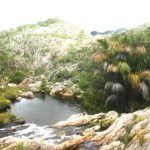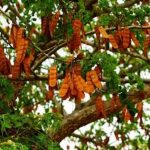TREE LIFE
SEPTEMBER 1995.
MASHONALAND CALENDAR
Tuesday 5th September. Botanic Garden Walk at 4.45 for 5 p.m. We will meet Tom in the public car park of the Gardens, where there will be a guard for the cars. The natural follow on to Acacia is the other species in this family, and by popular request Tom will show us Albizia, Newtonia, Xylia, Erythrina, etc. Please note that we are reverting to Tuesday evenings for the summertime walks.
Sunday 17th September. Our trip in January this year was to a wonderful spot near Mutorashanga and we promised ourselves a return visit.
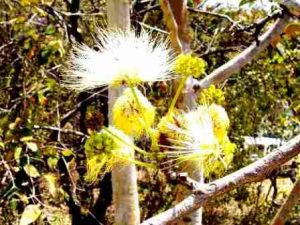
Albizia tanganyicensis. Photo: Mark Hyde. Source: Flora of Zimbabwe
M’torcha Mt. is on Kurt and Jenny Braunstein’s Kashwao Farm and it is with their kind permission that we return. The surrounding bush will probably be dry but the fringe at the base of the kopjie should be green and perhaps the Albizia tanganyicensis will be flowering. By midday you may even feel like a dip in the rock pool on the mountain. Allow about 1½ hours driving time to arrive at 10 a.m.
Saturday 23rd September. It is now two years since we looked at the weedy herbs in the vlei near Water World in Eastlea, so it’s time for another look to see what is new. Park in the Water World car park to meet Mark for his Botanic Interest walk at 3.00 p.m.
Tuesday 3rd October. Botanic Garden Walk.
MATABELELAND CALENDAR
Sunday 3rd September. We have reorganised things because Combretaceae will simply not provide sufficient material for another local outing and because we don’t expect to find much in leaf, flower or fruit. We shall have a video instead. The theme will be on Rainforests. We shall start at 10.00 a.m. (please note) break for tea (please provide for yourselves as the Girls’ College kitchen will be closed) and finish at about noon.
Friday 29th September to Sunday 1st October. Ikoro Safaris, West Nicholson. Self catering and primitive. Maximum 12 people. Booking on a first phone basis. Contact Ian or Margaret McCausland .
Sunday 5th November. For those who were unlucky with Ikoro we plan another weekend but have not settled our plans just yet. Our options are either for a return to Buchwa or a visit to Kana in the vicinity of the Gwayi/Shangani confluence. The next issue of Tree Life will give details.
Extra. Continuing with David Attenborough’s The Private Life of Plants on the 2nd Monday of each month at 7.45 for 8 p.m. at Girls’ College. The next, on Monday 11th September, will be episode 4 – Social Struggle. Then, episode 5 – Living Together; 6 – Surviving.
Sunday 2nd July 1995. In 1993 and 1994 we cancelled our July visits because of appalling weather – on both occasions arctic temperatures, rain and a howling gale had driven all but the foolish and the brave indoors. Would history repeat itself and break the wonderful Indian summer of late June?
At about 11 p.m. on Saturday 1st we heard the southeaster start and woke up on Sunday to a dismal grey sky and a fresh wind. We wondered just how many would turn up for a full day’s outing to Nata and made contingency plans for a shorter visit closer to town. By 8.30 we were only four strong and so set off for the Matopos.
Our first stop was at Sandy Spruit where we explored upstream and discovered an impressive waterfall. We returned to the picnic site for coffee and cake before moving on to the dwala north of World’s View. Our bracing walk over granite gave us panoramic views of the Mtsheleli and Maleme valleys and a good tree count even by Matopos standards (almost a hundred names). Lunch under a Pseudolachnostylis was followed by another walk and after tea we made a short journey to see the only specimen (to my knowledge because there must be others) of Antherothamnus pearsonii in the Matopos.
Our day had provided an impromptu recce of some very interesting sites which we will certainly build into a day in the Matopos at some time in the future.
-Ian McCausland
Oldlands Farm 16/7/95
The approach to the farm was typical of the dyke but once into the hollow the very attractive scenery unfolded with a dam between the shallow hills and a thickly wooded stream from which a number of Phoenix reclinata popped up above the dense green canopy of Syzygium. A day of unusual variation in soil types, from the deep vlei clays around the dam and stream to the occasional serpentine and the fine powdery red soils which had a dusting of tiny dark flecks, an indicator of the highly mineralised area. In the red dust along the road Rob Burrett noticed the signs of early man, not the shoe print of an early morning jogger, but the collection of small stone “flints” or hand tools from the Late Stone Age. These small pieces would have been split away from a larger lump of brown tinged Jaspilite by striking with another stone and the crystalline structure of this material would have made this shearing action much easier. Jaspilite is a rock that contains bands of quartz and hematite and/or magnetite, both of which are sources of iron ore when they occur in sufficient quantities. The reddish colour is caused by the staining of the quartz crystals by the iron oxide. This rock is more resistant to weather and than the banded ironstones found nearby and on the hill slopes. If Jaspilite is studied under high magnification the structure is actually in bands and is called monomineralic. Fortunately for the Dyke, jaspilite does not contain high iron content – the extraction of iron ore only being economic when the iron content is 50% or more, such as the reserves at Buchwa.
In spite of being within the fold of the dyke hills very little of the endemic flora was seen, however, an attractive shrub with dark green droopy leaves and white undersides produced a really medicinal smell when crushed. We puzzled over this for some time until Maureen appeared and provided the answer – Tarchonanthus camphoratus! The peppery aromatic resin of a leaf less Commiphora mossambicensis posed an interesting chemical question to Mary Toet with the scent being compared to glue and surprisingly toothpaste! Some people have a curious sense of smell! After a break in the warm sun a fairly steep hill beckoned with a Brachystegia glaucescens standing high on the ridge above. This area had been well pegged in the past by hopeful prospectors with claims signs popping up unexpectedly as we trundled our way up to the top with broken banded ironstone scattered over the hillside. These banded ironstone rocks which were full of blowholes probably resulting from the release of gases during cooling some time ago, generally assumed at 1950 million years, made a mini-ecosystem for numerous insects and ants.
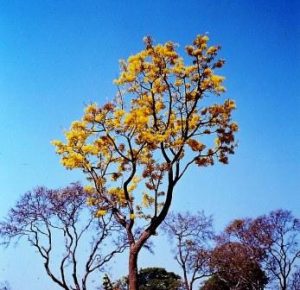
Ochna schweinfurthiana. Photo: Mike Bingham. Source: Flora of Zimbabwe
Some of the interesting sights on the hill were a large flat and rather untidy raptors nest whose occupant eyed us warily from the heavens and a really magnificent Ochna schweinfurthiana with the distinctive tiny horizontal slashes in the bark. A small cluster of rather stiff Ochna-like leaves looked like an 0chna gambeloides – something we don’t often see. An unexpected find on the hill top was a Protea petiolaris, tree-like with a twisted blackened trunk and glaucous leaves with pink petioles clustered on the ends of the branchlets. Among a colony of Faurea saligna a few unfortunate specimens had fallen over and the distinctive snake skin grain of the timber was still apparent in the decomposing timber. The lower slopes of the hill had seen some mining activity where the extraction of iron ore left the scars similar to what we found at the base of Buchwa Mountain. Acacia karroo and various Brachystegia were slowly recolonising the site, along with a few Ficus thonningii, Flacourtia indica and several fruiting Carissa edulis rounded off the number of species seen to 51.
Many thanks to Dozy and Boyce Kok for a very pleasant day in a scenic part of the Dyke. Thanks to Rob for his interesting snippet about early man and how Stone Age tools were utilised.
-Andy MacNaughtan
Trip to Engomeni Game Ranch, Shangani
In early August the Manser and Williams families did a trip to Engomeni which is a private game ranch about 25km south east of Shangani near Fort Rixon. We travelled down from Harare via Mvuma and noted that between Harare and Gweru the Msasa/Mnondo were predominant and suddenly as you turn south at Gweru you hit the Somabhula Flats which are undulating grasslands with nothing but the odd Mobola Plum breaking the monotony. About 20 or so km into the Somabhula area and on the west side of the road you do pass the fringe of the Somabhula Forest which appears to be 95% Mobola Plum. A point of historical interest is that during the Matabele War of 1893 the two columns of troops under Forbes and Allan Wilson narrowly missed being attacked by large hordes of Matabele warriors on the Somabhula flats. On that particular day there was a very heavy mist and the 45 wagons, 600 troops, 1000 Shona helpers, 400 horses and thousands of captured cattle and goats crept undetected past the Matabele using the mist and the thick Mobola forest as cover. Nearing Shangani one sees from the road mainly Terminalia and Acacia species.
In our party none of us could be termed tree boffins but I will detail some of the species that I could positively identify. I did cheat a bit as some of the trees around the farmhouse had already been labelled, probably by Ian McCausland and his band who, we noted from the visitors’ book, had done a day trip in early June ’94. The labels were a great help as in August the vast majority of trees are leafless, I am sure the drought hasn’t helped either.
Around the farmhouse we found masses of Euphorbia ingens, some of them being the biggest specimens I have ever seen, also Turraea nilotica, Mundulea sericea, Cussonia ‘octopus’, Lannea discolor, Dichrostachys cinerea, Diplorhynchus condylocarpon. Combretum molle, Commiphora mollis, Brachystegia glaucescens, Ozoroa insignis, Pterocarpus angolensis, Pterocarpus rotundifolius, Strychnos cocculoides, Maytenus senegalensis, Euclea divinorum, Terminalia sericea, Flacourtia indica and Clerodendrum glabrum which has the cute common name of white cat’s whiskers. I did come across numerous varieties of Acacias but was treading on very unsure ground here not having attended Tom’s recent Botanical Garden walks covering this subject. However most seemed to have black or orange bark which narrowed it down slightly. We did note that next to the farmhouse an Erythrina latissima in flower was marked Maytenus heterophylla, it had the correct tree number but I imagine the ranch folk got the labels mixed up. It was interesting to note that the main patches of greenery in this rather leafless environment were the odd Brachystegia spiciformis and Julbernardia globiflora plus some Ficus species and the Terminalia and evergreen Euphorbia ingens. One may think the ingens unclimbable by everything except the tree frogs but we did spot a Vervet monkey seemingly quite unconcerned sitting on the very pinnacle of a huge Euphorbia ingens surveying the surroundings. A very prickly position I would have thought for any animal no matter how light or agile.
On most days after a few hours we got “tree-itis” so spent time looking at the bird life and the various animals on the ranch which is stocked with giraffe, ostrich, eland, kudu, warthog, tsessebe, wildebeest, duiker, zebra and impalas. There is also a number a cheetah and leopard, the cheetah in particular becoming quite a pest to the surrounding cattle ranchers.
Also for a bit of a change from botanising we visited the nearby Dlodlo Ruins T V Bulpin mentions in his book To the banks of the Zambezi that these ruins are the most ornate, having nearly every known pattern of stone ornamentation. Those found here are chess¬board, chevron, cord and herringbone. Excavations at Dlodlo have revealed a variety of interesting objects – fragments of Nanking china, oil lamps, flintlock muskets, iron muzzle loaders, bronze cannons, gold and copper bangles and other items of jewellery. Growing amongst the ruins are Euphorbia ingens, Erythrina and various aloes, Aloe excelsa predominating.
On the way home travelling on the Gweru/Mvuma Road, it was a pleasure to see a bit more greenery and the Msasas and Mnondo showing off their new spring finery, lovely fleshy leaves in a fantastic array of oranges, browns, reds and greens.
Finally whilst on the subject of Mnondo – on a recent trip one of the Harare committee members, whom we shall call Rosie Mallaprop, got her tongue a bit twisted around the word Mnondo. She came out with MaHonda which sounded a bit Japanese and we have been teasing her unmercifully since, saying that she must not forget the MaSuzukis and MaYamahas.
-Bob Manser
MATABELELAND OUTING. 6th August 1995.
August 6th dawned cloudy. The warm gale force wind that the previous day had blown steadily and gustily from the north had become a cold south-westerly. Clearly convergence had taken place, shown by the navy blue sky in that direction. The higher clouds still drifted from the north. We learnt later that Harare had rain. Bracing ourselves against what promised to be a somewhat unpleasant day, the Bulawayo members sallied forth on the first part of a two part study devoted to Combretaceae.
Our first stop was a short distance down the Solusi road where we encountered Terminalia randii. Ian explained that at this season it was quite difficult to find such a one bearing leaves. The brown and red foliage was attractive, but none of the purple pods that grace this species lingered, although there were fallen seeds. These are the smallest fruit of the genus. My first sight of this tree is still vivid in my mind. A group of Terminalia randii was resplendent in snowy blossoms and breathtakingly beautiful. Ian observed astutely that where this tree occurs, mopane is not far away, both occurring generally on sodic soils.
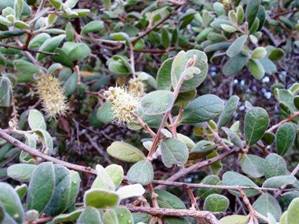
Combretum hereroense. Photo: Mark Hyde. Source: Flora of Zimbabwe
We returned to the Khami road and a little further were some fine examples of Combretum hereroense, known as the Mouse-eared Combretum. Theo confirmed that the seeds of this tree are brewed to make a tea that is used as a diuretic and could also be laxative.
Nearby, in the same vicinity stood a very venerable and large Combretum imberbe. It is remarked as the largest of its genus in the area. It is perhaps not quite as big as the famous one on the old Bulawayo road, but certainly competes very well with that particular tree.
Combretum imberbe is known as the Leadwood and has one of the densest woods known. Before the advent of metal, the indigenous people used this wood to fashion their hoes.
Another stop was made a little further down the Khami Road to view a group of River Combretum, Combretum erythrophyllum. Ian noted that this genus is not found far from rivers. There are a good many along the banks of the watercourse that meanders through the Bulawayo Golf Club. These are known to be very old. The outing proceeded along the road leading to the Mazwi Nature Park. By this time, the clouds had given way to sunshine and we were able to have our tea in a spot sheltered from the wind and warmed by the sun, before continuing. In this area we encountered several genera and species. Combretum apiculatum is perhaps the most wide¬spread and common of this family. Many of these trees still bore their brown and yellow autumnal foliage, and the characteristic four-winged fruit. On the other side of the road grew a group of Terminalia. Here we learnt the easy way to differentiate between Terminalia sericea and Terminalia brachystemma by using the “tongue test”. Terminalia sericea is hairy, but Terminalia brachystemma is usually glabrous. Coates Palgrave states “this species hybridises easily with Terminalia sericea.” What the tongue test tells us of hybrids is not recorded. Ian likened the structure of the Terminalia to the vaulted arching of a Cathedral, which was an excellent synonym. However, is not every tree a Cathedral in its own right?
We are told that the early explorers mistook Terminalia sericea for the Silver trees of the Cape Peninsula (Leucadendron argenteum) and in a good rainy season the leaves of Terminalia sericea are indeed silky and silvery.
A short walk over a granite slab took us to Combretum molle, whose velvet leaves were vibrant with the red shades of autumn.
Nearby grew some Combretum zeyheri. Nora queried the authority that identified this species and was happy to accept the name of one of our oracles who was not, however, present. But Ian dispelled all doubts when he found some seeds, the largest of the genus.
The ninth and final subject of our study was Combretum collinum, which is acknowledged to be difficult. Indeed, several trees nearby indicated as this species showed considerable variation in leaf structure, texture, colouring, as well as different barks. Coates Palgrave quotes 4 subspecies.
Ian concluded that there were not sufficient remaining subjects to warrant a second outing to study this family. We thank him most cordially for a most interesting and educational morning.
-Norma Hughes
On July 29th we were privileged to be guests of Werner Fibeck at a talk on Orchids Indigenous to Zimbabwe, which was illustrated with beautiful slides. Werner’s terrestrial orchid talk was followed by a short presentation by Mike Dare on epiphytic orchids. Suffice it to say that tremendously stimulating and exciting were adjectives useful to describe the show. Werner has kindly offered to summarise his talk for the benefit of those members who couldn’t be there and for revision for those who were. Orchid season is fast approaching and I am sure these notes will be tremendously helpful.
TERRESTRIAL ORCHIDS OF ZIMBABWE
95% of our terrestrial orchids have a perennial succulent storage organ (either a bulb or a tuber) growing at or below ground level and have deciduous non-succulent leaves. This so-called ‘caudiciform succulence’ enables the plants to adapt more easily to the long dry season on the highveld. An annual precipitation of 700 mm is sufficient for many terrestrial species. Consequently, terrestrial orchids have a much wider distribution than their epiphytic relatives and they occur not only in the Eastern Highlands, but also throughout Mashonaland and in large areas of the Midlands and Masvingo provinces.
These more favourable conditions explain the evolution of a diversified terrestrial orchid flora, well represented with at least 246 species in 32 genera (73% of all orchid species in Zimbabwe) with an impressive variety in shape, colour and beauty. Isabyl La Coix, an authority on African orchids at Kew (UK) stresses, “African terrestrials include some of the most colourful of all orchids” (American Orchid Society Bulletin 1994, p 1130).
Zimbabwe’s terrestrial orchid flora is dominated by the genera Eulophia (63 species) and Habenaria (59 species), followed by Satyrium (20) and Disa (19). These four genera contain 66% of the 246 terrestrial orchids, with the remaining 34% being in 28 genera.
Eulophia is the largest genus of approximately. 250 species. This genus is pan-tropical, but mainly African. It is the best-adapted genus to the conditions of the Highveld, with a wide variety of species occurring in very different savannah habitats. Species vary from nearly hydrophytic to xerophytic. Eulophia grow in chains of variously shaped bulbs or tubers, which are mostly below ground level. The flower spike, arising from the base of the tubers, varies considerably in height depending on the species (from a mere 10 cm to more than 2.5 m).
Eulophia species are the first terrestrial orchids to flower in any new season, and may behave like typical succulents after dormancy. With a fascinating speed, just triggered by the rise in temperature, they burst into new growth and colourful flowering often even before the first shower of rain. Fortunately, most of the large-flowering species are still widespread and very common in this country, especially in woodlands.
Habenaria is a very large pan-tropical genus of approx. 500 species. The majority of species have green-white or green-dominated flowers. Some are dull; some are beautiful in a strange way, while others seem to mimic spiders, praying mantis or other insects. These plants grow from round or elongated tubers and the flower spike is terminal. Plants are often overlooked when flowering in habitat, because they are so perfectly camouflaged with their greenish flowers, which appear mainly in the second half of the rainy season from January to March. Half the species occur in woodland, while the other half grow in grassland and vlei.
Satyrium is a large genus of approx. 100 species centred in South Africa. The flower spike is terminal with many flowers, and colours range from green, yellow, and white through pink, purple and red. Satyrium are easily distinguished from other orchids because the flowers are non-resupinate and have twin spurs (nectar tubes) borne on the hooded lip. Most species flower during the peak of the rainy season from late December to February and they are found growing in grassland and vlei.
Disa is a large genus of approx. 130 species with the centre of speciation in South Africa. This genus contains some of the most beautiful of all African orchids. The flower is terminal and species have either over a hundred small flowers or a few flowers. The distinctive feature of this genus is the spur formed from the hooded dorsal sepal. These plants flower from late December onwards and they generally favour high rainfall areas, such as the grasslands and vleis of the Eastern Highlands. Those species occurring on the highveld grow in wet vleis.
For the orchid lover in Zimbabwe one of the great attractions is that something can be found in every type of soil and habitat during the different phases of the rainy season – except whore disturbed by human activities. Prior to and at the onset of the rains one should try looking in woodland dominated by Msasa trees often near rocky outcrops with pockets of leaf-mould, for different Eulophia species. From January onwards, woodland and forest are still rich habitats, but now Habenaria and other genera are found flowering.
However, the “best” habitats in terms of number of species and absolute numbers of plants are now vlei, bog and grassland. Mainly Disa, Satyrium, Habenaria, a few wet-growing Eulophia and other genera occur in these habitats.
Theoretically, almost every vlei should contain some flowering orchids during the second half of the rainy season. Unfortunately, however, most vlei habitats, both in the commercial and communal farming areas, have been destroyed by grazing cattle.
-Werner Fibeck
BOTANIC GARDEN WALK: 5 AUGUST 1995
Acacias, part 4. This month Tom gave us the last session on Acacias by looking at a number of straight-thorned species.
Acacia rehmanniana occurs in a variety of habitats but is commonly found along streams. It has many pinnae (over 25) and hairy shoots. In the latter feature, it resembles Acacia gerrardii but the latter has fewer pinnae. The young branches are often red or reddish-brown (like Acacia karroo). The fruits are broad and ± straight (unlike both karroo and gerrardii). The flowers are white. Typically, the tree is fairly small, but large specimens do occur.
Acacia nilotica has totally distinctive pods, which are relished by cattle. The leaves have relatively few pinnae and are similar to Acacia gerrardii, but are glabrous. This species occurs in every kind of association, from the lowveld to the highveld.
The Fever Tree (Acacia xanthophloea) with its absolutely distinctive greenish-yellow bark occurs only at very low altitudes in seasonally flooded swamps in the SE of Zimbabwe. It is commonly planted around Harare and appears to do very well. As Tom pointed out, although it only grows in this specialised habitat in the wild, this does not mean that it will not do well in cultivation, even if the conditions are very different.
Moving from the lowest altitudes to the Eastern Districts, we next looked at Acacia abyssinica. This occurs in situations that are moist but not moist enough for forest. It is typically flat-topped and has considerable similarities to Acacia sieberiana and Acacia rehmanniana, however the bark is much more flaking than sieberiana. Furthermore, the leaf is longer in relation to the width (c. 5 x in abyssinica as opposed to c. 2 x in sieberiana). The pods of Acacia sieberiana are exceptionally thick and often almost indehiscent, whereas Acacia abyssinica has thin, dehiscent papery pods.
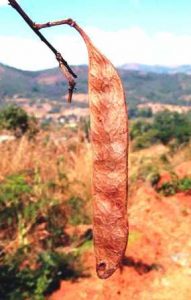
Acacia amythethophylla. Photo: Rob Burrett. Source: Flora of Zimbabwe
On to Acacia amythethophylla, a common middle altitude species, which has yellow flowers in large inflorescences (this is what was meant by its former name Acacia macrothyrsa). The leaves are also exceptionally large, resembling a Jacaranda.
Faidherbia albida typically occurs along lowveld rivers, where it is an early coloniser of sand. It has straight thorns and flowers in spikes, and this breaks the normal rule. The fruit is shaped like an apple ring. This species has leaves in the dry season but is totally leafless in the rainy season. Like Acacia xanthophloea, this is commonly encountered out of its normal range as a planted tree.
Finally, Acacia erioloba, with its very long pinnae and very short midrib. This is a climax tree, unlike many Acacias, which are succession species. It can be a very large tree on occasions and may be flat-topped. The pod is thick, short, curved, velvety and broad.
Next month, by popular request, Albizia and the other genera in the Mimosoideae. This will include such genera as Newtonia, Amblygonocarpus and Xylia.
-Mark Hyde
SNIPPETS
In 1945, living trees of the fossil genus Metasequoia were discovered in China, and the species was named Metasequoia glyptostroboides. It was found to grow easily from cuttings, and we received some here in Zimbabwe in the 1950s. The best specimens grew to heights of 9 metres and diameters of more than one metre at La Rochelle Botanical Garden, near Penhalonga, before succumbing to the drought of 1991/92.
In 1995 living trees of a fossil genus were discovered in a secluded gorge in a rainforest in New South Wales, Australia, according to a report in the Daily Telegraph. No name was given for the fossil genus, which was thought to have become extinct 150 million years ago, but the recently discovered living species has been given the English name Wollemi pine. The trees are reported to be up to 40 metres tall and about one metre in diameter. They are covered in dense, waxy foliage and have a distinctive bark that makes them appear to be “coated with bubbly chocolate”.
In WILDLIFE ZIMBABWE, July-September 1995, there is a short note on the mesquite, Prosopis sp., extolling its virtues as a fuel-wood for economically deprived people in sub-Saharan Africa among other places. In Coates Palgrave’s Trees of Southern Africa Prosopis (an American tree) is recorded as having become naturalised over considerable areas of Namibia, possibly even extending into the northern Cape. And in a recent issue of the Commonwealth Forestry Review an article on the risks of species introductions notes that hybrids between certain species of Prosopis introduced into South Africa “have become extremely invasive, with the ability to colonise a wider range of habitats than either of the parent species”. In this same article it was also noted that Acacia nilotica, which is promoted for its browse and fodder value in Africa and India, is being eradicated as a noxious weed in Queensland, Australia, and in Indonesia, having become suddenly invasive some 50 years after being introduced into these two countries.
-Lyn Mullin
ANDY MACNAUGHTAN CHAIRMAN


